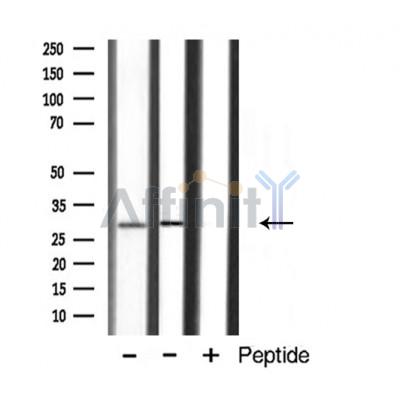AIBP Antibody - #DF3781
| Product: | AIBP Antibody |
| Catalog: | DF3781 |
| Description: | Rabbit polyclonal antibody to AIBP |
| Application: | WB IF/ICC |
| Reactivity: | Human, Mouse, Rat |
| Prediction: | Pig, Zebrafish, Bovine, Horse, Sheep, Dog, Xenopus |
| Mol.Wt.: | 30 KD; 32kD(Calculated). |
| Uniprot: | Q8NCW5 |
| RRID: | AB_2836138 |
Related Downloads
Protocols
Product Info
*The optimal dilutions should be determined by the end user. For optimal experimental results, antibody reuse is not recommended.
*Tips:
WB: For western blot detection of denatured protein samples. IHC: For immunohistochemical detection of paraffin sections (IHC-p) or frozen sections (IHC-f) of tissue samples. IF/ICC: For immunofluorescence detection of cell samples. ELISA(peptide): For ELISA detection of antigenic peptide.
Cite Format: Affinity Biosciences Cat# DF3781, RRID:AB_2836138.
Fold/Unfold
AI BP; AIBP; ApoA I binding protein; Apolipoprotein A I binding protein; MGC119143; MGC119144; MGC119145; NAD(P)H hydrate epimerase; NAD(P)HX epimerase; YjeF N terminal domain containing protein 1; yjeF_N1; YJEFN1;
Immunogens
A synthesized peptide derived from human AIBP, corresponding to a region within the internal amino acids.
Ubiquitously expressed, with highest levels in kidney, heart and liver. Present in cerebrospinal fluid and urine but not in serum from healthy patients. Present in serum of sepsis patients (at protein level).
- Q8NCW5 NNRE_HUMAN:
- Protein BLAST With
- NCBI/
- ExPASy/
- Uniprot
MSRLRALLGLGLLVAGSRVPRIKSQTIACRSGPTWWGPQRLNSGGRWDSEVMASTVVKYLSQEEAQAVDQELFNEYQFSVDQLMELAGLSCATAIAKAYPPTSMSRSPPTVLVICGPGNNGGDGLVCARHLKLFGYEPTIYYPKRPNKPLFTALVTQCQKMDIPFLGEMPAEPMTIDELYELVVDAIFGFSFKGDVREPFHSILSVLKGLTVPIASIDIPSGWDVEKGNAGGIQPDLLISLTAPKKSATQFTGRYHYLGGRFVPPALEKKYQLNLPPYPDTECVYRLQ
Predictions
Score>80(red) has high confidence and is suggested to be used for WB detection. *The prediction model is mainly based on the alignment of immunogen sequences, the results are for reference only, not as the basis of quality assurance.
High(score>80) Medium(80>score>50) Low(score<50) No confidence
Research Backgrounds
Catalyzes the epimerization of the S- and R-forms of NAD(P)HX, a damaged form of NAD(P)H that is a result of enzymatic or heat-dependent hydration. This is a prerequisite for the S-specific NAD(P)H-hydrate dehydratase to allow the repair of both epimers of NAD(P)HX.
Undergoes physiological phosphorylation during sperm capacitation, downstream to PKA activation.
Mitochondrion. Secreted.
Note: In sperm, secretion gradually increases during capacitation.
Ubiquitously expressed, with highest levels in kidney, heart and liver. Present in cerebrospinal fluid and urine but not in serum from healthy patients. Present in serum of sepsis patients (at protein level).
Belongs to the NnrE/AIBP family.
Restrictive clause
Affinity Biosciences tests all products strictly. Citations are provided as a resource for additional applications that have not been validated by Affinity Biosciences. Please choose the appropriate format for each application and consult Materials and Methods sections for additional details about the use of any product in these publications.
For Research Use Only.
Not for use in diagnostic or therapeutic procedures. Not for resale. Not for distribution without written consent. Affinity Biosciences will not be held responsible for patent infringement or other violations that may occur with the use of our products. Affinity Biosciences, Affinity Biosciences Logo and all other trademarks are the property of Affinity Biosciences LTD.

